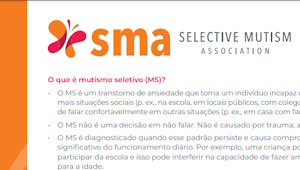Online Library
Speech Language Therapy and Selective Mutism
The following information relates to the work of speech-language pathologists and how they may contribute to the treatment benefits of children with selective mutism (SM).
Speech and Language
Both speech and language are important to the therapeutic process. The term speech refers to verbalized sound productions uttered to form words and sentences. (Speech output may include an augmentative-alternative device but for children with SM the reference here is speech that is produced by the individual). Intelligible speech requires coarticulation of sounds based on quickly changing oral contacts of active and passive articulators of the mouth (lips, teeth, tongue, palate, alveolar ridge, mandible, etc.). Areas of speech include articulation, voice, and fluency. Language functioning, also necessary to engage in interactive communication, requires comprehension of language and the ability to formulate thoughts into connected words and sentences for self-expression. Areas of language include semantics, syntax, morphology, phonology, and pragmatics.
Pragmatic language is especially impacted in individuals with SM and relates to (1) using language for different purposes such as informing or requesting; (2) changing language to meet the needs of the situation such as knowing how to speak differently to different people; and (3) following rules of conversational discourse to take turns when speaking, to stay on topic, and to initiate topics of interest, to name a few. Greeting people, making requests, relating events, and telling stories are just a few pragmatic tasks. For a broader review of this area see https://www.asha.org/public/speech/development/pragmatics.htm
Recent Findings About Speech and Language Problems Associated with SM
Recent research (Klein, Armstrong, Shipon-Blum, Gordon, Skira, & Lyman, 2012) collected over a four-year period with 146 children diagnosed with SM found that 25%
of the children had a unitary language disorder with no speech impairments. Language deficits involved decontextualized language, compound & complex sentences, mean length of utterance, narrative language, and the ability to express thoughts verbally. A total of 12% of the children had a unitary speech articulation disorder with no other voice, fluency, or language impairments; 3% presented with only stuttering (a fluency disorder), and 1% had a voice disorder with no other concomitant speech-language disorders. However, it should be noted that many children presented with a combination of speech and language impairments. A total of 17% had various combinations of speech, language, fluency, and voice disorders. An additional 23% had a combined speech articulation and language disorder. Only 19% of the total group had no speech or language impairments.
Within the total sample of 146 children diagnosed with SM, 59% displayed some form of language deficit and 42% of the total sample produced speech that was not correctly articulated.
Assessing Speech and Language
A certified speech-language pathologist (SLP) generally has the appropriate training and skills to help treat children with communication deficits related to selective mutism (SM). Treatment requires knowledge of the disorder and information about the child’s speech and language skills. The SLP uses informal and formal measures to learn about the child’s speech articulation, voice (pitch, quality, and loudness), fluency (rate and rhythm), and language comprehension and expression. Questionnaires, observations, and direct evaluations are used. The SLP identifies how the child communicates in various settings and with various people. The child with SM may be non-communicative, engage in communication that is nonverbal (gesture, nod, point, write, draw, or use an alternative communicative device) or the child may be verbal at varying degrees and may whisper, use one word responses, speak in an altered voice, speak with scripted phrases or sentences, or speak in a normal voice using spontaneous language. Hearing testing and an oral-motor examination are also important to obtain. Parents may be needed to assist in test item presentations if the child is not able to communicate with the SLP. Several tests that are easily modified for this purpose include the Peabody Picture Vocabulary Test (PPVT), Expressive Vocabulary Test (EVT), and the Test of Narrative Language (TNL). See Klein, Armstrong, & Shipon-Blum (2013) for a complete review of the testing procedures.
Speech and Language Treatment Considerations for SM
Therapeutic intervention is often necessary to help the child progress from non-communicative to non-verbal and on to verbal communication. Children with SM tend to do well with behavioral approaches as the mute behavior is believed to be a response to socially mediated anxiety when speech is expected (Cohan, Chavira, Shipon-Blum, Hitchcock, Roesch, & Stein, 2008). SLPs, in connection with other professionals, often set goals with gradual increases in expectations.
The Ritual Sound Approach® (RSA) has had good success using shaping to reinforce the child’s oral movements with sounds that become closer to producing phonemes and real words. This approach starts with voiceless speech sounds that require less vocal effort in that they don’t engage the vocal cords. Children feel air move in and out of their mouths as they breathe, blow, and cough. Thus, voiceless speech sounds such as /h/ (similar to breathing), /k/ (similar to a cough), /s/, /t/, /p/, etc. are used because they are less audible than vowels or voiced consonant sounds such as /z/, /d/, /b/, /g/, etc. RSA® is part of Social Communication Anxiety Treatment ® (S-CAT; Shipon-Blum, 2010). This cognitive and behaviorally based treatment helps the child think of sound-making from a mechanical standpoint (e.g. put lips together lightly, build up air pressure in the mouth and puff out air to produce the sound of /p/). Children use the alphabet and cross off sounds of letters they can produce. They also underline syllables with the added benefit of distraction as they look at a paper with the therapist (joint attention) and not at the person with whom they are communicating. These features help reduce speaking anxiety. Sounds are shaped to form a word when blended together. This chaining technique in RSA® helps children begin to speak using voiceless consonants first (h, s, f, t, etc.) that are later connected with vowels and consonant sounds to form words.
Augmented self-modeling is another treatment technique that has promise for reducing anxiety when speaking (Kehle, Bray, Byer-Alcorace, Theodore, & Kovac, 2011). The child watches videotaped segments of herself or himself during a positive verbal interchange (often at home) and then visually (through playback) carries the communicative interchange into another setting that is often more challenging. Using video software, the child can get a virtual glimpse into communicating successfully in a setting that causes heightened anxiety. Collaborating with the psychologist or counselor who is working to help reduce the child’s anxiety is suggested.
When working with children with SM it is important to keep in mind that a difference exists between voicing for speech versus voicing for vegetative tasks (crying, coughing, laughing, etc.). Voicing for speech is purposeful and thus requires good control for functional flow and fluency. In many instances coordinating voice and speech while thinking of what to say (linguistically) becomes difficult for children with SM due to anxiety. Therefore, non-speech tasks may be used to help the children gain control of voicing. Once vocal control in non-speech tasks is adequate then speech can be introduced slowly and systematically to allow for success and maintenance of vocal control (Cesar Ruiz, personal communication, March, 2013). The following are suggestions by C. Ruiz, voice specialist, to help accomplish the tasks above:
- Begin with a very quiet humming sound as the initial vocal task.
- Ask children to hold it as long as possible providing demonstration (possibly using a puppet). Reward them for adding seconds to the trials. Lightly putting two fingers on the bridge of each side of the nose will help to feel a vibration. You may also have them feel the vibration on your nose or a familiar person’s nose (parent) to compare (if willing).
- Have them attempt to change pitch (high to low and/or low to high). They can feel their throat (Adam’s apple area) with their fingers and it should rise for the higher pitch and lower for the lower pitch hums.
- Try Apps such as Bla Bla Bla™, Magic Voice™ or other similar software, such as Voice Games™ by KayPentax™, which can react to
the child’s voice.
- Ask children to make the sound of an animal or engage in noise-making such as knocking, clapping, snapping, clicking, making an engine sound, airplane sound, etc.). This can become a guessing game. Try this on one side of a half-open door in order to reduce someone looking at them. You can guess the sound they are making. This may be an easier task for some children than others.
- After spending some time on steps 1 & 2 children should be demonstrating better control of voice initiation. Now would be the time to introduce speech. Ask them to produce a hum and while keeping the voice “on” change into a vowel. For example start with mmmmmmaaaaaaaah. Practice all vowels with /m/ to start.
- Now the hum becomes the /m/ sound. Use /m/ initiated words to increase length (ex: mmmmother, mmmmilk, etc.)
- As children progress you may introduce /m/ sentences (Ex: my mother makes monstrous meatballs).
- Once comfortable with /m/ words, introduce non-/m/ initiated syllables, words, phrases and sentences. If children are having difficulty using voicing, remind them about humming.
There are several available resources incorporating a variety of other treatment options that are broader than the speech-language scope. These include: Child Anxiety Disorders: A Guide to Research and Treatment – 2nd edition (Beidel & Alfano, 2011); Treatment for Children with Selective Mutism: An Integrative Behavioral Approach (Bergman, 2013); Helping Children with Selective Mutism and Their Parents: A Guide for School-Based Professionals (Kearney, 2010); Unlocking the Mystery of Selective Mutism and Social Anxiety (Kotrba, 2012); Selective Mutism Conference: Speaking Out for Kids (Kurtz, 2011); Helping Your Child with Selective Mutism (McHolm, Cunningham, & Vanier, 2005); The Selective Mutism Treatment Guide (Perednik, 2011); and The Selective Mutism Summer Vacation and Back to School Guide (Shipon-Blum, 2012), to name a few. Professionals may also find the Selective Mutism Questionnaire (SMQ; Bergman, Keller, Piacentini, & Bergman, 2008, a validated instrument for identifying and comparing speaking behaviors in various settings), to be a useful tool.
Incorporating Speech and Language Development into SM Treatment Goals
While a substantial number of children with SM exhibit age-appropriate language development (as would be expected given APA diagnostic criteria for SM), a substantial number of children with SM exhibit language deficits or delays (Klein, Armstrong, & Shipon-Blum, 2012; Cohan, Chavira, Shipon-Blum, Hitchcock, Roesch, & Stein, 2008). As SM is a disorder that prevents communication with a variety of speaking partners, children often do not obtain the experience to become effective conversationalists. In other words, being able to initiate, maintain, and change topics may be challenging. Pragmatics and discourse are often compromised. Therefore, simultaneous treatment using both behavioral strategies to help children feel more comfortable to speak and linguistically based activities to foster language development are recommended. A team approach combining psychological and speech-language therapies is often best practice. Speech-language intervention should be incorporated early in treatment, especially for children who present with a language delay. Some children will need basic vocabulary development, grammatical morpheme development, and work on sentence structure. For many children with SM, the goal will be to enhance social-pragmatic communication with work on enhancing the following abilities:
- descriptive language (vocabulary and describing)
- expository language (informing and explaining)
- narrative language (storytelling) and
- discourse for social communication (discussing and interacting).
The delivery of speech-language therapy is best guided by a communicative hierarchy such as one including the following levels:
- Communicate by pointing, gesturing, or nodding (use games, toys, and age-appropriate projects)
- Communicate by drawing or writing (use games requiring these modalities)
- Talk through a recording device that is played when out of the room and then when in the room (as comfort increases)
- Talk to another person who speaks for the child (in front of others with increasing distance from the person’s ear)
- Talk to others using sounds (may be blended to form words)
- Talk to others using rehearsed or scripted language with and without visual prompts (develop charts to play guessing games – include phone as possible)
- Talks spontaneously using words or phrases (including phone)
- Talks spontaneously using sentences (including phone)
There are many programs and games that can foster language opportunities. Depending on the child’s age, the SLP may consider: Guess Who ®, Guess Where®, I Spy®, Bingo®, Ned’s Head®, Battleship®, Uno®, Mad Libs®, Go Fish®, Charades®, Scattegories®, Scribblish®, Hangman®, and Jeepers Peepers®, to name a few. An introductory resource is The Source® for Selective Mutism (Richard, 2011). This manual describes some assessment and treatment options and resources for professionals. Program manuals and apps are also available to work on improving sentence structure and narrative language.
Some SLPs work with children through a private practice or clinic but they often work in the child’s school and classroom along with teachers to help improve communication and reduce anxiety related to speaking. Small group therapy has been found effective in facilitating communication with peers. Initially, it is less threatening to engage in nonverbal play but it is also important to move toward speaking situations that may include scripted single words and phrases. Reducing demands for spontaneous speech output early in therapy may be helpful. In doing so, it is suggested that the communicative partner wait at least 5 seconds for the child with SM to reply, thereby giving them time to process information and plan a response. Sometimes giving two options for a choice helps the child respond. Remember, parents are a very important part of the therapy process and should be kept well-informed about treatment goals and gains so that they can help foster and reinforce progress.
Hung, Spencer, & Dronamraju (2012) support the SLP’s role in the classroom with initial play therapy sessions. These may include the use of a puppet, reading a book, or playing a game. Desensitization and shaping often help encourage speech. According to Hungerford, Edwards, & Iantosca (2003), a socio-communicative approach is suggested when treating SM and includes speech and situational variables with social engagement as a goal. Proxemics, kinesics, eye gaze, non-verbal turn-taking, writing, and participation in joint activity routines, are all considered to be part of communication. Communication, not just talking, is seen as essential. Children with SM need to feel a sense of comfort and success with communication. Initially, it is recommended that SLPs work on nonverbal skills of social engagement and later gear treatment toward more specific communication including speech training. An eclectic approach that combines motivational reinforcement, shaping, stimulus fading, and generalization is recommended.
Speech articulation therapy may also be part of the treatment protocol for children who have speech production errors, either sound substitutions, distortions, omissions, or additions. Children with SM tend to be perfectionistic and have heightened sensitivity so they may be tuned into their own speech sound errors which make them anxious and avoid speaking. They may also worry about the possibility that another child may tease them about their speech. Silence may be one of their perceived solutions. In addition, some children with SM believe they cannot speak in some settings and so they may not properly engage their respiration, voice, or articulation appropriately. Children with SM can get accustomed to not speaking and thereby assume the self-image of the child who does not talk (Omdal, 2007). This self-fulfilling prophecy is one that can persist without appropriate intervention.
As research expands within the field of SM, more conferences, publications, and other learning opportunities are becoming available. Each year, the Selective Mutism Association hosts a national conference. Noted scholars continue to advance the field.
Contributed by: Evelyn R. Klein, PhD, CCC-SLP and Sharon Lee Armstrong, PhD
References
Beidel, D.C., & Alfano, C.A. (2011). Social anxiety disorder and selective mutism. In
Child anxiety disorders: A guide to research and treatment (2nd ed.). NYC: Routledge.
Bergman, R.L. (2013). Treatment for children with selective mutism: An integrative behavioral approach. Oxford: Oxford University Press.
Bergman, R. L., Keller, M. L., Piacentini, J., & Bergman, A. J. (2008). The Development and Psychometric Properties of the Selective Mutism Questionnaire. Journal of Clinical Child and Adolescent Psychology, 37(2), 456-464.
Cohan, S.L., Chavira, D.A., Shipon-Blum, E., Hitchcock, C. Roesch, S.C., & Stein, M.B. (2008). Refining a classification of children with selective mutism: A latent profile analysis. Journal of Clinical Child & Adolescent Psychology, 37(4). 770-784.
Hung, S.L., Spencer, M.S., & Dronamraju, R. (2012). Selective Mutism: Practice and
Intervention Strategies for Children. Children and Schools, 34(4), 222-230.
Hungerford, S., Edwards, J., & Iantosca, A. (2003, November). A socio-communication intervention model for selective mutism. Paper presented at the American Speech-Language-Hearing Association Convention, Chicago, IL. Retrieved from https://www.asha.org/uploadedFiles/slp/clinical/selectivemutismmodel.doc
Kehle, T.J., Bray, M.A., Byer-Alcorace, G.F., Theodore, L.A., & Kovac, L.M. (2011).
Augmented self-modeling as an intervention for selective mutism. Psychology In
The Schools, 49(1), 93-103.
Kearney, C. (2010). Helping children with selective mutism and their parents: A guide for school-based professionals. Oxford: Oxford University Press.
Klein, E.R., Armstrong, S.L., Shipon-Blum, E., Gordon, G., Skira, K., & Lyman, B. (2012, October). Cognitive, psychological, and linguistic features of children with
selective mutism. Paper presented at the Selective Mutism Group Annual Conference, Orlando, FL.
Klein, E.R., Armstrong, S.L., & Shipon-Blum, E. (2013). Assessing spoken language
competence in children with selective mutism: Using parents as test presenters. Communication Disorders Quarterly, 34, 184-195.
Kotrba, A. (2012). Unlocking the mystery of selective mutism and social anxiety. [DVD]. Available from https://www.pesi.com
Kurtz, S. (2011, October). Child Mind Institute: S. Kurtz (Chair), Speaking out for kids
conducted at the annual Selective Mutism Group – Childhood Anxiety Network
Conference conducted at Hunter College, NYC. Retrieved from http://www.childmind.org/en/posts/articles/2011-11-2-2011-selective-mutism-conference-speaking-out-kids
McHolm, A.E., Cunningham, S.E., & Vanier, M.K. (2005). Helping your child with
selective mutism. Oakland, CA: New Harbinger Publications.
Omdal, H. (2007). Can adults who have recovered from selective mutism in childhood and adolescence tell us anything about the nature of the condition and/or
recovery from it? European Journal of Special Needs Education, 22(3), 237-253.
Perednik, R. (2011). The selective mutism treatment guide. Jerusalem, Israel: Oaklands.
Richard, G. J. (2011). The source for selective mutism. East Moline, IL: LinguiSystems.
Shipon-Blum, E. (2012). The Selective Mutism Summer Vacation and Back to School
Guide. Retrieved from http://www.drelisashiponblum.org/catalog/item/4251814/9402924.htmShipon-
Blum, E. (2010). Transitional stage of communication. Retrieved from
http://www.selectivemutismcenter.org/Media_Library/Missinglink.pdf .




